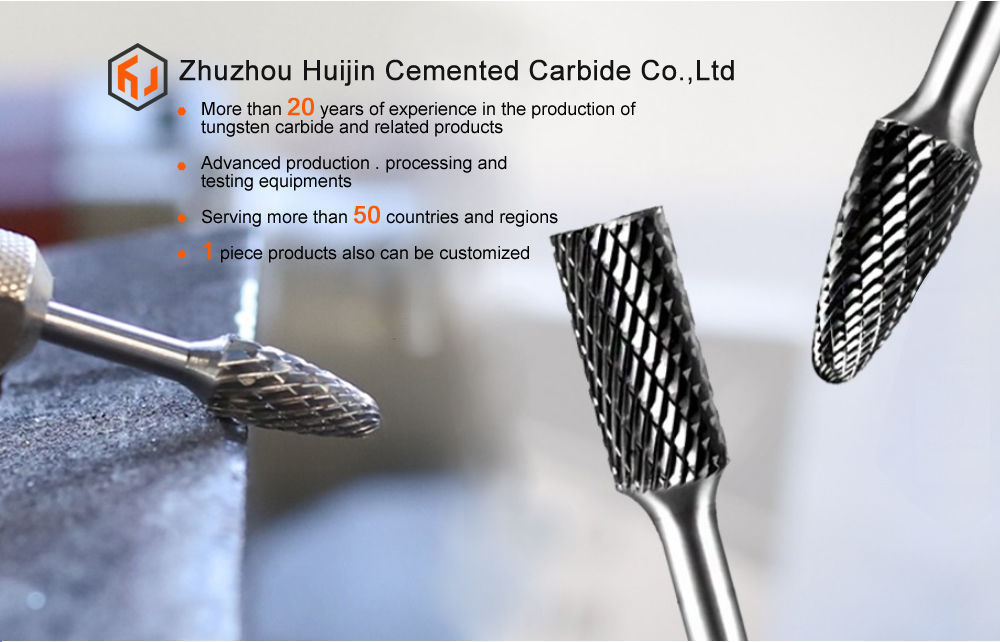Tungsten carbide rotary burrs or files are powder metallurgy products made of micron-sized powder of high-hardness refractory metal carbides (WC, TiC) as the main component, cobalt (Co) or nickel (Ni), molybdenum (Mo) as binders, and sintered in a vacuum furnace or hydrogen reduction furnace.

Application:
Carbide rotary burrs are widely used in industrial sectors such as machinery, automobiles, ships, chemicals, and craft carving. The main uses are:
(1) Finishing of various metal mold cavities.
(2) Craft carving of various metals (cast iron, cast steel, carbon steel, alloy steel, stainless steel, copper, aluminum, etc.) and non-metals (jade, marble, bone, etc.).
(3) Cleaning of flash, burrs, and welds of castings, forgings, and welds, such as foundries, shipyards, and automobile factories.
(4) Chamfering and groove processing of various mechanical parts, cleaning of pipes, and finishing of the inner hole surface of mechanical parts, such as machinery factories and repair factories.
(5) Polishing of impeller flow passages, such as automobile engine factories.
Specifications and models:
| Rotary burr type and sizes | ||||||
| Shape & Type | Order No. | Size | ||||
| Cut Dia | Cut Length | Shank Dia | Overall Length | Taper Angle | ||
| A | A0616M06 | 6 | 16 | 6 | 61 | |
| A0820M06 | 8 | 20 | 6 | 65 | ||
| A1020M06 | 10 | 20 | 6 | 65 | ||
| A1225M06 | 12 | 25 | 6 | 70 | ||
| A1425M06 | 14 | 25 | 6 | 70 | ||
| A1625M06 | 16 | 25 | 6 | 70 | ||
| B | B0616M06 | 6 | 16 | 6 | 61 | |
| B0820M06 | 8 | 20 | 6 | 65 | ||
| B1020M06 | 10 | 20 | 6 | 65 | ||
| B1225M06 | 12 | 25 | 6 | 70 | ||
| B1425M06 | 14 | 25 | 6 | 70 | ||
| B1625M06 | 16 | 25 | 6 | 70 | ||
| C | C0616M06 | 6 | 16 | 6 | 61 | |
| C0820M06 | 8 | 20 | 6 | 65 | ||
| C1020M06 | 10 | 20 | 6 | 65 | ||
| C1225M06 | 12 | 25 | 6 | 70 | ||
| C1425M06 | 14 | 25 | 6 | 70 | ||
| C1625M06 | 16 | 25 | 6 | 70 | ||
| D | D0605M06 | 6 | 5.4 | 6 | 50 | |
| D0807M06 | 8 | 7.5 | 6 | 52 | ||
| D1009M06 | 10 | 9 | 6 | 54 | ||
| D1210M06 | 12 | 10 | 6 | 55 | ||
| D1412M06 | 14 | 12 | 6 | 57 | ||
| D1614M06 | 16 | 14 | 6 | 59 | ||
| E | E0610M06 | 6 | 10 | 6 | 55 | |
| E0813M06 | 8 | 13 | 6 | 58 | ||
| E1016M06 | 10 | 16 | 6 | 61 | ||
| E1220M06 | 12 | 20 | 6 | 65 | ||
| E1422M06 | 14 | 22 | 6 | 67 | ||
| E1625M06 | 16 | 25 | 6 | 70 | ||
| F | F0618M06 | 6 | 18 | 6 | 63 | |
| F0820M06 | 8 | 20 | 6 | 65 | ||
| F1020M06 | 10 | 20 | 6 | 65 | ||
| F1225M06 | 12 | 25 | 6 | 70 | ||
| F1425M06 | 14 | 25 | 6 | 70 | ||
| F1625M06 | 16 | 25 | 6 | 70 | ||
| G | G0618M06 | 6 | 18 | 6 | 63 | |
| G0820M06 | 8 | 20 | 6 | 65 | ||
| G1020M06 | 10 | 20 | 6 | 65 | ||
| G1225M06 | 12 | 25 | 6 | 70 | ||
| G1425M06 | 14 | 25 | 6 | 70 | ||
| G1625M06 | 16 | 25 | 6 | 70 | ||
| H | H0618M06 | 6 | 18 | 6 | 63 | |
| H0820M06 | 8 | 20 | 6 | 65 | ||
| H1025M06 | 10 | 25 | 6 | 70 | ||
| H1232M06 | 12 | 32 | 6 | 77 | ||
| H1636M06 | 16 | 36 | 6 | 81 | ||
| J | J0605M06 | 6 | 5.2 | 6 | 50 | 60° |
| J0807M06 | 8 | 7 | 6 | 52 | 60° | |
| J1008M06 | 10 | 8.7 | 6 | 53 | 60° | |
| J1210M06 | 12 | 10.4 | 6 | 55 | 60° | |
| J1613M06 | 16 | 13.8 | 6 | 58 | 60° | |
| K | K0603M06 | 6 | 3 | 6 | 48 | 90° |
| K0804M06 | 8 | 4 | 6 | 49 | 90° | |
| K1005M06 | 10 | 5 | 6 | 50 | 90° | |
| K1206M06 | 12 | 6 | 6 | 51 | 90° | |
| K1608M06 | 16 | 8 | 6 | 53 | 90° | |
| L | L0616M06 | 6 | 16 | 6 | 61 | 14° |
| L0822M06 | 8 | 22 | 6 | 67 | 14° | |
| L1025M06 | 10 | 25 | 6 | 70 | 14° | |
| L1228M06 | 12 | 28 | 6 | 73 | 14° | |
| L1428M06 | 14 | 28 | 6 | 73 | 14° | |
| L1633M06 | 16 | 33 | 6 | 78 | 14° | |
| M | M0618M06 | 6 | 18 | 6 | 63 | 14° |
| M0820M06 | 8 | 20 | 6 | 65 | 25° | |
| M1020M06 | 10 | 20 | 6 | 65 | 25° | |
| M1225M06 | 12 | 25 | 6 | 70 | 25° | |
| M1425M06 | 14 | 25 | 6 | 70 | 30° | |
| M1625M06 | 16 | 25 | 6 | 70 | 32° | |
| N | N0607M06 | 6 | 7 | 6 | 52 | 20° |
| N0809M06 | 8 | 9 | 6 | 54 | 20° | |
| N1011M06 | 10 | 11 | 6 | 56 | 20° | |
| N1213M06 | 12 | 13 | 6 | 58 | 20° | |
| N1616M06 | 16 | 16 | 6 | 61 | 20° | |

How to choose Carbide rotary burr/ file
1. Selection of the cross-sectional shape of carbide rotary burr
The cross-sectional shape of carbide rotary burr tools should be selected according to the shape of the parts being filed, so that the shapes of the two are adapted to each other. When filing the inner arc surface, choose a semicircular file or a round file (for small diameter workpieces); when filing the inner angle surface, choose a triangular file; when filing the inner right angle surface, you can choose a flat file or a square file, etc. When using a flat file to file the inner right angle surface, pay attention to making the narrow side (light edge) of the file without teeth close to one of the inner right angle surfaces to avoid damaging the right angle surface.
2. Selection of file tooth thickness
The thickness of the file teeth should be selected according to the allowance size, processing accuracy, and material properties of the workpiece to be processed. Coarse-tooth files are suitable for processing workpieces with large allowances, low dimensional accuracy, large form and position tolerances, large surface roughness values, and soft materials; otherwise, fine-tooth files should be selected. When using, choose according to the processing allowance, dimensional accuracy, and surface roughness required by the workpiece.
3. Selection of carbide file size specifications
The size specifications of carbide rotary burr should be selected according to the size of the workpiece being processed and the processing allowance. When the processing size and allowance are large, a large-sized file should be selected, otherwise a small-sized file should be selected.
4. Selection of file tooth pattern
The tooth pattern of tungsten steel grinding head files should be selected according to the properties of the workpiece being filed. When filing soft material workpieces such as aluminum, copper, and soft steel, it is best to use a single-tooth (milling tooth) file. The single-tooth file has a large front angle, a small wedge angle, a large chip groove, and is not easy to clog with chips. The cutting edge is sharp.
POST TIME: 2024-07-25













